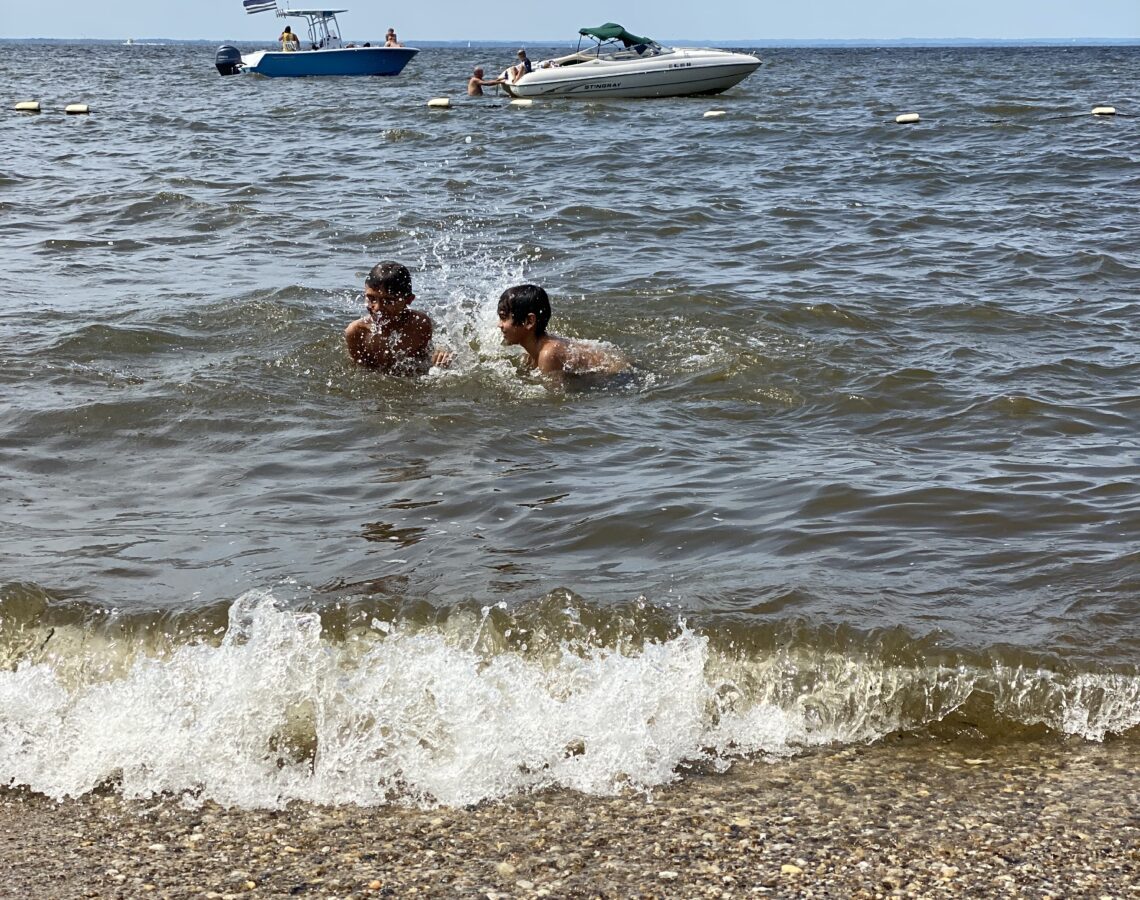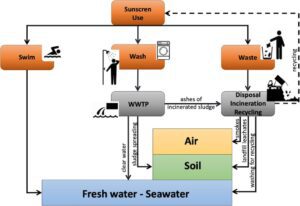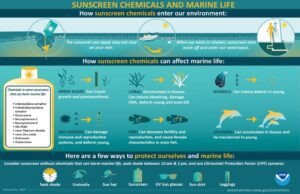Issue 4 | June 2022 | Summer in Maryland

By Josalyn Bonney, CSH2O Intern
Maryland’s relationship with the Chesapeake Bay allows for many fun activities in the summer (and for some die-hards, all year round!) However, these interactions can also have consequences for the aquatic and terrestrial life that live in and around the bay. Farming and agriculture are already known influences on the water composition but there are others that some people may not think about.  During the hottest months of the year, many people use sunscreen to protect themselves from the Ultraviolet (UV) rays. However, once those same people jump in the water, the chemicals from the sunscreen wash off into the bay. With an increase of people swimming, this influx can have a negative effect on the environment.
During the hottest months of the year, many people use sunscreen to protect themselves from the Ultraviolet (UV) rays. However, once those same people jump in the water, the chemicals from the sunscreen wash off into the bay. With an increase of people swimming, this influx can have a negative effect on the environment.
In a study done by the University of Maryland, Baltimore County, researchers found UV ray filtering chemicals used in commercial sunscreens along with antibiotics and endocrine-disrupting hormones in Bay water, bottom sediments and oyster tissue taken from the mouth of the Chester River and three water bodies on the Lower Eastern Shore. Even indirect pathways such as showering or hand washing can lead to a significant increase in these chemicals. Unfortunately, most of the effects these pollutants have are unknown, although one was found to have a high enough level to make potentially disease-causing bacteria resistant to treatment.
Wastewater plants are thought to be a major contributor of these harmful chemicals, especially ones located near main  rivers like the Chester. Admittedly not all compounds found in the study were related to sunscreen, with some being byproducts from poultry farms or household septic systems. Still, sunscreen chemical levels do pose a threat to more sensitive aquatic life and proactive measurements should be taken to limit their longevity within the ecosystem.
rivers like the Chester. Admittedly not all compounds found in the study were related to sunscreen, with some being byproducts from poultry farms or household septic systems. Still, sunscreen chemical levels do pose a threat to more sensitive aquatic life and proactive measurements should be taken to limit their longevity within the ecosystem.
It has been found that sunscreen levels have aided in the degradation of coral reefs. An important component to this habitat is an algae called zooxanthellae; this species helps the coral photosynthesize and provides nutrients. Sunscreen chemicals have  caused this algae to be affected by viruses from manmade ingredients. These viruses activated within zooxanthellae replicate until their algal hosts explode, spilling viruses into the surrounding seawater, which could then spread infection to nearby coral communities. These disastrous effects act very quickly and are often incorporated into the surrounding area within four days, even with miniscule quantities.
caused this algae to be affected by viruses from manmade ingredients. These viruses activated within zooxanthellae replicate until their algal hosts explode, spilling viruses into the surrounding seawater, which could then spread infection to nearby coral communities. These disastrous effects act very quickly and are often incorporated into the surrounding area within four days, even with miniscule quantities.
Researchers estimate that approximately 10% of the world’s coral reefs are potentially threatened by sunscreen that washes off swimmers in reef waters. The study suggests that, as tourism continues to increase in tropical reef areas, the impact of sunscreens on coral bleaching could rise significantly in the future.
While these effects may seem distant and isolated, it is important to remember that all water is connected. What happens to the far-off coral reefs will, somehow, impact the Chesapeake Bay that is right outside our back door and, conversely, what happens to the Bay will impact coral reefs. This means that what is done in the oceans has large-scale effects elsewhere in the world and vice versa. Sunscreen chemicals are inorganic (e.g. not produced naturally) so they cannot be broken down by the natural system. This leads to buildup of harmful compounds that can cause extensive and rapid bleaching (corals become white) of the reefs and can disrupt reproductive systems in filterers such as our local oysters. Even the lowest concentrations of sunscreen chemicals can have catastrophic effects on this sensitive environment.
Thankfully it’s not all bad news; the U.S. has developed UV filter bans to prevent an increase of damaging chemicals from entering the waterways. Additionally, the market for organic-based sunscreens has seen an expansion in recent years which is good for both the environment and personal use! You can read more about environmentally-safe sunscreens under our newsletter’s section Be Sunscreen Smart!
References
Wheeler, Timothy B. (2019). Sunscreen Chemicals Found in Bay Oysters. Chesapeake Bay Magazine.
Tibbetts, John (2018). Bleached, But Not by the Sun: Sunscreen Linked to Coral Damage.

